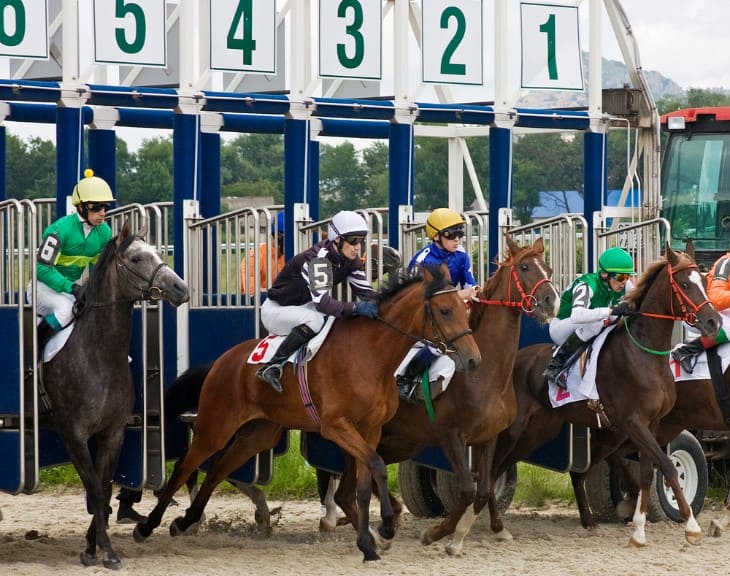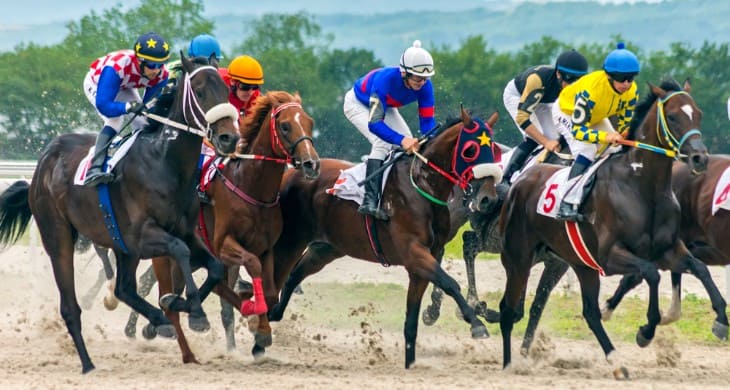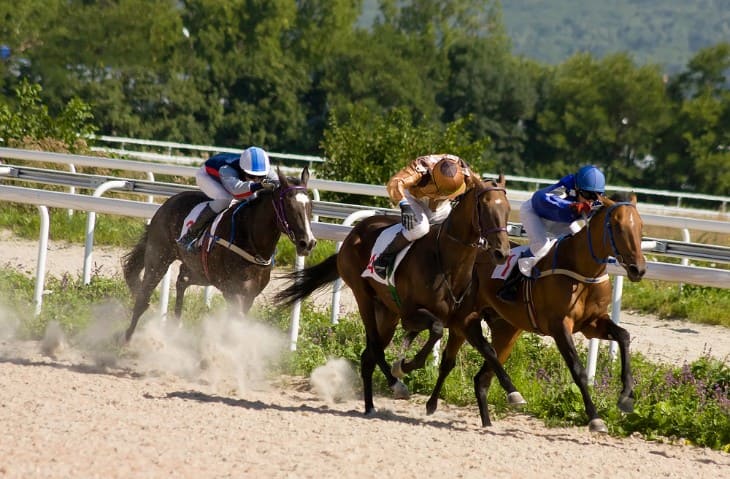Flat racing is one of the most exciting forms of horse racing, thrilling the world with its speed, tactics and sheer thrill. The dynamics of flat racing cannot be truly understood without a deep understanding of the blend between speed and tactics that characterise this sport.
This article explores the universe of flat racing, exposes jockeys’ and trainers’ strategies and gives valuable insights into why this sport is so captivating.
The Essence of Flat Racing: The Need for Speed
Unlike steeplechase where the tracks have undulating terrain, flat racing derives its name from taking place on even surfaces. The essence behind all flat races is in their title because they require thoroughbred horses to push themselves to their utmost limits to win a race. These magnificent animals are bred and trained specifically for speed capacities, making them the centre of attention.
The Sprinters and Stayers
In flat racing, there are two main categories with distinct characteristics; sprinters versus stayers. This has to do with different traits they have as runners or distances they specialise in during races.
The Sprinters:
Flat racing hounds sprint out like Usain Bolt on a racetrack. Sprint races usually range from five to seven furlongs translating into approximately one or one and a half kilometres respectively. What sets sprinters apart for instance is how fast they take off at an explosive rate achieving maximum velocity within seconds after launching out faster than other competitors who may still be taking off over shorter distances.
The Stayers:
Staying power distinguishes itself as being long-distance running equivalent to flat racing. Typically longer races which might go up to two miles or more suit them best. Stamina makes stayers extraordinary among others. They can maintain a consistent pace throughout while being able to accelerate whenever required because these horses cover ground effectively even over long distances hence strong contenders when it comes to far-off events.
For trainers and punters alike, categorising runners into either sprinters or stayers is crucial. To race his or her horse in appropriate events, a trainer has to pick races that go hand in hand with its strengths and attributes. However, long-distance races are not meant for sprinters while a stayer cannot be made to compete against his or her nature.
Each category has its unique qualities and talents. Quickness and acceleration are the hallmarks of sprinters who often either win or lose at the starting bell. By contrast, staying horses requires patience as well as a tactical approach when it comes to their racing which is more like a marathon than it is a sprint.
These categories underscore the variedness and multiplicity within flat racing whereby different kinds of horses find their niche within this sphere hence mesmerising an audience with their natural abilities not only physical but also athletic. As part of this thrilling sport, both these types, including speedsters and stayers form an enchanting fabric.
Strategies in Flat Racing: The Tactical Chessboard
While speed is important in flat racing, it does not mean that every fast horse will always win. The game plan implemented by jockeys together with trainers can determine whether they will emerge winners too if everybody else plays well in terms of tactics. Hence we look at some tactics on the fly used during flat racing on this occasion.

Positioning Matters
In the fast-paced world of flat racing, positioning doesn't mean just getting a place on the track; it is an essential strategic move that often makes all the difference between a win and a loss. Let us now examine why positioning is so vital in this exciting sport.
- Strategic Advantage: Positioning is not about chance; it's about strategy. During races, jockeys try to place their horses in the best positions possible. It may be closer to the rail or following the leader because it can shelter from winds and shorten distances that the horse has to cover.
- Avoiding Traffic: Horses can get caught up in "traffic" during a race, just like in a traffic jam. A horse stuck behind a phalanx of runners finds it hard to quicken or respond when prompted for action. Skilled riders navigate their mounts by finding gaps and avoiding congestion.
- Energy Conservation: Racing is as much about conserving energy as it is about speed. Horses that pour too much energy into early stages might tire out at crucial moments of ending stretches. Proper placing enables jockeys to exercise control over pace hence saving the horse's power for later.
- Strategic Manoeuvers: Jockeys use positioning for planning their strategies. They appraise their horses' strengths and weaknesses, then select appropriate times for attacking or overtaking moves. Being in the right position at the right time could change the course of any horse race.
- Adapting to Conditions: Changes in track conditions are relative to positioning them properly. For instance, intelligent riders know how best they can keep horses correctly positioned depending on whether the tracks are wet or dry.
- The Final Dash: At those last thrilling moments before crossing the finish line, one cannot underestimate how important positioning becomes. Riders want their steeds stationed perfectly such that by letting go this final spurt of pace will abruptly see them through the finishing kick.
Pace and Timing
In breathtaking flat racing, understanding the subtleties of pace and timing is everything. These features can mean a horse will win or lose in a race. Let us probe into why pace and timing are essential in this absorbing sport.
- Early Pace: The early pace, which is the speed at which a race begins, sets its mood. Horses that burst out of the gate with blazing speed may tire themselves out too soon. On the other hand, some horses conserve energy in the early stages so they can make strong finishes.
- Mid Race Strategy: As an event advances, jockeys need to evaluate their adversaries’ position and rate of running. On some occasions, races have fast first paces whereas others are more tactical and careful situations. They have to adapt their tactics accordingly
- Final Stretch: The most exciting part is when jockeys reach the home straight in a flat race. At this point, it's all about timing. Jockeys should be able to get maximum acceleration from their mounts at exactly the right moment. For purposes of overtaking rivals as one approaches the finishing line one needs split-second decision-making.
- Photo Finish: In many cases, there's an inch between victory and second place in flat races. This determines who wins through when the foot touches down lastly; it gives you a clue who has made the final stride quickest enough for the opposite side to take that vital passage across the finishing line first by just horse nose length.
- Training and Preparation: Behind the scenes, trainers prepare horses for races, with a focus on pace and timing during workouts. This is important if they are to have the endurance and acceleration needed for an effective race.
The Finishing Kick
In flat racing, where races can be won or lost in a matter of seconds, the finishing kick is a heart-stopping moment. At the end of a race, this sudden increase in acceleration is like nothing else and its knowledge is crucial to any fan of horse racing.
- Timing is Everything: The finishing kick has everything to do with timing. Jockeys must determine when it’s right to let loose their horse’s maximum speed. If one pushes too hard, then tiredness may result while waiting for too much will lead to missed opportunities. Striking a balance that separates winners from others.
- Physical Fitness: To deliver an explosive finishing kick, horses must be in top physical condition. Their training programs mainly concentrate on stamina development and speed explosiveness. It’s over the final furlong that their many months of grafting bear fruit.
- Jockey's Expertise: Skilled jockeys are masters of the finishing kick. They understand their horse's capabilities and know when to ask for that extra burst of speed. Their tactical acumen often proves decisive in the closing moments of a race.
- Psychological Factors: The atmosphere of the racecourse, the presence of competitors, and the roar of the crowd can all impact a horse's performance. Some horses thrive under pressure and find extra gear when it matters most, while others may falter.
- The Roar of the Crowd: The crowd plays a significant role in the finishing kick. As the horses thunder down the final straight, the deafening cheers of spectators can motivate horses to dig deep and find that last burst of speed.
The Global Stage: Flat Racing Across the World
Flat racing transcends borders and is celebrated on a global scale. From the prestigious Royal Ascot in the United Kingdom to the Kentucky Derby in the United States and the Dubai World Cup in the United Arab Emirates, flat racing events capture the imagination of racing enthusiasts worldwide.
Prestigious Events
The Epsom Derby (United Kingdom)
The Epsom Derby, often referred to simply as "The Derby," is one of the most prestigious and historic flat horse races in the United Kingdom. It takes place at Epsom Downs Racecourse in Surrey, England. The Derby is known for its rich tradition and as one of the five classic races in the UK.
Held annually in early June, The Derby is open to three-year-old thoroughbred horses. It covers a distance of one mile, four furlongs, and six yards, making it a test of both speed and stamina. The race is famous for its challenging undulating track, including the infamous Tattenham Corner, where jockeys and horses face a sharp left turn.
The Epsom Derby has a storied history dating back to its inaugural running in 1780. It attracts top-class horses, trainers, and jockeys from around the world, making it a global sporting spectacle. The race's roll of honour includes legendary horses and jockeys, adding to its prestige.
Winning The Derby is a dream for owners, trainers, and jockeys, and it often marks a horse's place in history. The event is steeped in tradition, from the singing of the national anthem to the presentation of the coveted trophy.

The Melbourne Cup (Australia)
The Melbourne Cup is Australia's most famous horse race, often referred to as the "race that stops a nation." Held annually on the first Tuesday in November, it's a major sporting and cultural event in Australia. The race takes place at Flemington Racecourse in Melbourne, Victoria.
This prestigious event attracts thoroughbred horses from around the world, and it's a true test of stamina. The Melbourne Cup covers a distance of 3200 metres (about 2 miles), making it one of the longest flat races in the world.
The Melbourne Cup is known not only for its thrilling horse racing but also for its fashion and social traditions. Attendees dress in their finest attire, and there's a tradition of wearing extravagant hats and fascinators. The race is also famous for the "Fashions on the Field" competition, where the best-dressed attendees are recognized.
Winning the Melbourne Cup is a dream for owners, trainers, and jockeys, and it cements a horse's place in history. The race has a rich history dating back to 1861 and has seen many legendary horses and jockeys grace its track.
The Breeders' Cup (United States)
The Breeders' Cup is a prestigious horse racing event held annually in the United States. It's a championship series that showcases some of the finest thoroughbred horses from around the world. The location of the event varies each year, adding an element of excitement.
Founded in 1984, the Breeders' Cup consists of multiple races across different distances and surfaces, making it a true test of versatility for the participating horses. The event typically takes place in late October or early November, attracting top-class competitors.
One of the distinguishing features of the Breeders' Cup is its emphasis on the quality of the racing. The prize money offered is substantial, making it a lucrative opportunity for owners, trainers, and jockeys. Each race is a championship in its own right, and winning a Breeders' Cup race is a significant achievement in the world of horse racing.
The Breeders' Cup has produced memorable moments and legendary performances over the years, and it continues to draw a global audience of racing enthusiasts. It's a showcase of speed, skill, and the undeniable bond between horses and their human partners.
The Global Appeal
Horse racing is not just a sport; it's a global phenomenon that captivates audiences in various corners of the world. Whether it's the historic tracks of the United Kingdom, the high-stakes races in the United States, or the thundering hooves in Australia, horse racing has a universal charm.
One of the reasons for its global appeal is the sheer diversity of the sport. Different countries have their unique racing traditions, from flat racing to steeplechase events. Each region has its star horses, legendary jockeys, and iconic races that capture the imaginations of fans.
Horse racing is also an international language. The excitement of a photo finish, the anticipation before the gates open, and the thunderous roar of the crowd as the horses charge towards the finish line are universal experiences that transcend language barriers.
The global appeal of horse racing is further heightened by major international events like the Dubai World Cup, the Japan Cup, and the aforementioned Breeders' Cup. These events bring together the best horses from different countries, creating a sense of unity in the world of racing.
Conclusion
Flat racing's dynamics, driven by the need for speed and the intricacies of tactics, make it a thrilling spectacle for fans and punters alike. Understanding the delicate balance between these elements is key to appreciating the beauty of flat racing.
Whether you're a seasoned enthusiast or a newcomer to the world of horse racing, the blend of speed and tactics in flat racing is sure to keep you on the edge of your seat. So, the next time you watch a flat racing event, you'll have a deeper understanding of the strategies at play on the racetrack.








